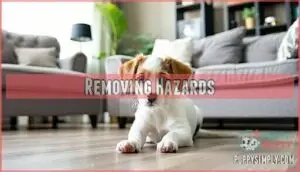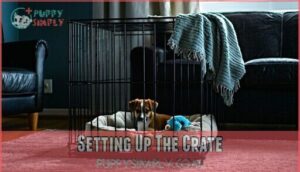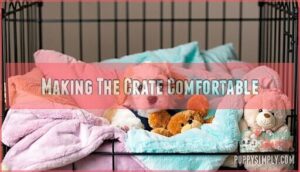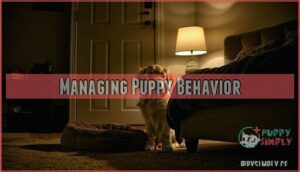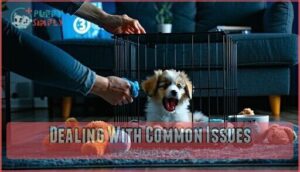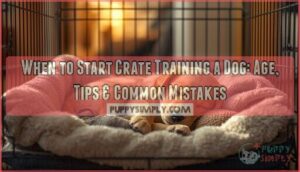This site is supported by our readers. We may earn a commission, at no cost to you, if you purchase through links.
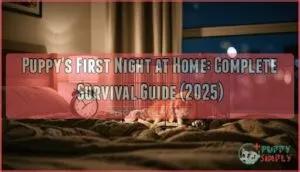
Set up a cozy crate near your bedroom so you can hear them without giving in to every whine. Place a soft blanket and maybe a ticking clock inside to mimic their mother’s heartbeat.
Take them out for a final potty break right before bed and expect at least one middle-of-the-night bathroom trip. Don’t rush to comfort every sound they make or you’ll create a demanding habit.
Most puppies adjust within a few nights once they realize you’re nearby and they’re safe in their new den, and understand that you’re not going to comfort them at every little whine.
Table Of Contents
- Key Takeaways
- Preparing Puppy Essentials
- Setting Up Puppy Space
- Crate Training Basics
- Establishing Nighttime Routine
- Managing Puppy Behavior
- Potty Training Fundamentals
- Dealing With Common Issues
- Ensuring a Smooth Transition
- Frequently Asked Questions (FAQs)
- Should you let a puppy cry it out the first night?
- What to expect on a puppy’s first night home?
- What type of collar should I buy for my puppy?
- How soon should I begin obedience training?
- What is the best way to introduce a new puppy to my other pets?
- How do I know if my puppy is displaying signs of separation anxiety?
- How often should I take my puppy for walks?
- What temperature should the room be for puppy?
- When should I first introduce puppy to vet?
- How do I handle puppys first car ride?
- Conclusion
Key Takeaways
- Set up a cozy crate near your bedroom – Your puppy needs a safe, den-like space where they can hear you but will not be rewarded for every whine, helping them feel secure while learning independence.
- Expect crying and accidents but do not give in – It is completely normal for your puppy to whimper and have bathroom mishaps their first night, but responding to attention-seeking behavior creates demanding habits you will regret later.
- Follow a strict nighttime routine – Feed your puppy 3-4 hours before bed, take them out for a final potty break, and set alarms for midnight bathroom trips to prevent accidents and establish good habits.
- Stock up on essentials before they arrive – You will need enzyme cleaners for accidents, soft bedding with familiar scents, properly sized food bowls, and puppy-proofed spaces so you are not scrambling to pet stores when you are already exhausted.
Preparing Puppy Essentials
Getting the right supplies before your puppy arrives can save you from late-night trips to the pet store when you’re already exhausted.
You’ll need the basics like food bowls, a collar, a crate, and cleaning supplies – think of it as building your puppy survival kit.
This preparation is crucial for a smooth transition into puppy ownership, ensuring you have everything necessary to care for your new pet.
Food and Water Bowls
Before your puppy arrives, you’ll need the right feeding setup.
Choose sturdy, easy-to-clean bowls that won’t tip over during enthusiastic puppy feeding sessions.
- Bowl Material: Stainless steel or ceramic works best for durability and hygiene
- Bowl Size: Start small and upgrade as your puppy grows
- Bowl Placement: Position on easy-to-clean surfaces away from high-traffic areas
- Cleaning Frequency: Wash daily with warm soapy water
- Elevated Bowls: Wait until your puppy’s fully grown before considering raised feeders
Consider using durable feeding solutions for your puppy.
Puppy Food
Your new puppy’s nutritional needs differ substantially from adult dogs.
Keep feeding the same puppy food from their previous home for two weeks to avoid digestive upset during food switch.
High-quality puppy food supports rapid growth with proper portion control.
Establish a consistent feeding schedule with three daily meals.
Positive reinforcement can be used during feeding to create a positive association.
Monitor for food allergies and consult your vet about ideal puppy feeding practices.
Collar and Leash
After securing proper nutrition, your new puppy needs a comfortable collar and reliable leash.
Focus on collar sizing with a two-finger gap between neck and collar for safety. Choose soft, adjustable materials that won’t irritate delicate skin.
Consider harness options for smaller breeds. Selecting the appropriate neck size is essential for comfort.
Don’t forget ID tags with your contact information – they’re lifesavers if your curious pup wanders off during those first adventurous days.
Crate and Dog Bed
Your dog bed and puppy crate will become your pup’s personal sanctuary on their first night.
Choose a crate size that accommodates their adult dimensions—you don’t want them swimming in space.
The den instinct kicks in naturally when bedding options include soft blankets and safe toys.
Smart crate placement near your bedroom helps everyone sleep better during those inevitable midnight wake-ups, utilizing the pup’s natural instinct.
Grooming Tools
Basic grooming tools set the foundation for your puppy’s health and comfort during those first few nights.
Starting early helps them adjust to handling, which reduces stress when they’re already overwhelmed.
- Soft brush – Gentle bristles for sensitive puppy skin and coat maintenance
- Mild puppy shampoo – pH-balanced formula for delicate skin protection
- Puppy toothbrush and toothpaste – Essential dental hygiene tools for early training
Consider using an undercoat rake for double-coated breeds.
Emergency Cleaning Supplies
Beyond basic grooming supplies, you’ll need accident-fighting weapons in your arsenal.
Stock up on enzyme cleaners that break down odor-causing proteins from puppy accidents. Paper towels, disinfectant wipes, and stain prevention sprays are lifesavers.
Keep training pads handy for quick cleanup. Consider DIY solutions like white vinegar for surface safety.
Trust me—accidents happen faster than you think.
Setting Up Puppy Space
Your home needs to become a safe haven for your new puppy before they walk through the door.
You’ll need to puppy-proof dangerous areas and create a cozy sleeping spot where your furry friend can feel secure on their first scary night away from mom and littermates.
Puppy-Proofing The House
Your new puppy will explore every corner like a furry detective.
Your curious pup will sniff, paw, and investigate every nook and cranny with relentless determination.
Think of puppy proofing as childproofing but for four-legged explorers who chew everything.
Start with these priorities:
- Secure chemicals in locked cabinets – cleaning supplies and medications pose serious risks
- Remove toxic plants like lilies and azaleas from puppy’s reach
- Protect furniture with covers or barriers to prevent destructive chewing habits
Removing Hazards
Sweep through each room like a detective hunting for trouble.
Tuck away electrical cords, secure toxic substances like cleaning products, and lock up all medication.
Your new puppy will treat small objects like tasty snacks, so clear floors completely.
Puppy proofing your home means thinking like a curious four-legged explorer who’s determined to taste everything within reach, and it requires a thorough approach to ensure safety, by making your home puppy proof and understanding that your puppy will be a four-legged explorer.
Creating a Quiet Sleeping Area
After securing your home from hazards, focus on your puppy’s sleeping sanctuary.
Choose a quiet corner away from household traffic and loud noises for sound dampening. Guarantee proper temperature control and draft prevention by avoiding windows and air vents.
Add soft bedding options with familiar scents from their previous home. This peaceful setup reduces puppy crying during crate training puppy sessions on that vital puppy first night with proper temperature control.
Crate Training Basics
Think of a crate as your puppy’s personal bedroom where they can feel safe and secure during those overwhelming first nights.
You’ll want to choose the right size crate and set it up with cozy bedding so your new friend has a comfortable den to call their own.
Choosing The Right Crate
Your puppy’s first crate becomes their personal sanctuary. Getting the right one sets the foundation for peaceful nights ahead.
Here’s what matters most when selecting your puppy crate:
- Crate Size – Measure your pup’s adult weight to pick the perfect fit
- Material Matters – Wire crates offer visibility while plastic feels more den-like
- Crate Features – Adjustable dividers grow with your furry friend
- Door Placement – Side-opening doors work best in tight spaces
- Brand Comparison – Research durability ratings before buying
This safe space becomes their sleeping area sanctuary. Placing the crate in the bedroom helps with separation and anxiety.
Setting Up The Crate
Position your puppy crate in a quiet corner away from heavy foot traffic and direct sunlight.
Choose the right crate size with room to stand and turn around comfortably. Use a divider to adjust the space as your pup grows.
Initial placement should be near your bedroom for easy nighttime access. This safe space becomes their personal den for security.
Making The Crate Comfortable
Creating your puppy’s crate into a cozy retreat makes all the difference on their first night.
Think of it as building their personal bedroom. Add soft crate bedding, select one or two comfort items like a plush toy, and include something with your scent for familiarity.
- Soft blankets that smell like home and safety
- A favorite stuffed animal to cuddle when loneliness strikes
- Your worn t-shirt for comforting scent association
- A special chew toy to ease anxious moments
Establishing Nighttime Routine
Creating a consistent nighttime routine helps your puppy adjust to their new home and sets everyone up for better sleep.
Think of it like teaching a toddler bedtime habits – you’ll need a clear plan for feeding times, potty breaks, and where your furry friend will sleep.
Feeding Schedule
Your crate setup is complete, but timing meals correctly makes all the difference for your new puppy’s first night.
Feed your puppy their final meal 3-4 hours before bedtime. This prevents midnight bathroom emergencies while ensuring proper digestion.
| Meal Time | Food Quantity | Notes |
|---|---|---|
| Morning (7 AM) | 1/3 daily portion | Start day strong |
| Afternoon (12 PM) | 1/3 daily portion | Midday energy boost |
| Evening (5 PM) | 1/3 daily portion | Final meal timing |
| Bedtime (9 PM) | No food | Digestive rest period |
Potty Breaks
Set your alarm every two hours for nighttime potty breaks during those first vital weeks.
Your puppy can’t hold it long, so consistency matters for successful housetraining.
Watch for restless whining or circling – these are potty cues. Take them straight to their designated toilet spot, reward immediately after they go, then back to bed.
Accident cleanup happens; schedule adherence prevents most mishaps.
Sleep Setup
Generally, your puppy’s first night sleeping setup determines success or failure.
Place the puppy crate near your bed to ease bedtime anxiety and provide comfort during those inevitable midnight potty calls.
Create a cozy sleep environment with soft blankets and familiar comfort items.
Consider gentle nightlights and calming sound machines to help establish a peaceful bedtime routine for restful puppy sleep.
Managing Puppy Behavior
Your puppy’s first night will likely include some crying, barking, or accidents as they adjust to their new home.
Understanding how to respond to these normal behaviors will help both you and your furry friend get through the night with less stress, and this knowledge is crucial for a smooth adjustment.
Addressing Crying
Your puppy’s crying stems from separation anxiety – they’re missing their littermates and mom.
Place their crate near your bed for nighttime reassurance during gradual adjustment. Comfort measures like soft blankets help, but avoid reinforcing whining with excessive attention.
Ignoring attention-seeking cries prevents learned behavior. Remember, puppy anxiety is normal on their first night. Patience wins.
Reducing Barking
While crying stems from anxiety, barking often signals different needs.
Your pup might bark from boredom, excitement, or responding to outside sounds.
Here’s how to tackle nighttime barking:
- Feed meals inside the crate – creates positive associations
- Gradually increase door closure time – builds comfort slowly
- Provide mental stimulation before bed – tired minds whine less
Remember, some breed tendencies affect barking triggers naturally.
Handling Accidents
Accidents happen during housetraining—it’s part of the puppy journey. You’ll need proper cleaning solutions for odor removal and surface protection.
Don’t let training setbacks discourage you. Clean thoroughly with enzymatic cleaners to prevent repeat marking. Take preventative measures by increasing potty breaks and monitoring your puppy’s toilet schedule closely.
Many owners find that it helps to wake puppy up to pee during the night, especially in the early stages.
| Accident Type | Cleaning Solution | Prevention Strategy |
|---|---|---|
| Urine on carpet | Enzymatic cleaner + blotting | More frequent potty breaks |
| Poop on hardwood | Disinfectant + paper towels | Watch for sniffing signals |
| Vomit on fabric | Baking soda + vinegar | Monitor eating schedule |
| Multiple accidents | Professional carpet cleaner | Restrict house access |
| Repeat marking | Blacklight detection + deep clean | Supervise constantly |
Potty Training Fundamentals
You’ll need to start potty training from day one to help your new puppy learn where it’s okay to go to the bathroom.
Setting up a clear schedule with regular potty breaks and rewarding your puppy when they go in the right spot will make this process much easier for both of you, as it involves rewarding your puppy.
Creating a Schedule
Success with your new pup starts with building a rock-solid puppy schedule.
Your furry friend thrives on predictability, so establishing consistent routines makes everything easier.
Here’s your daily framework:
- Consistent Wake-Up at the same time each morning
- Feeding Times spaced 4-6 hours apart
- Structured Playtime between meals and naps
- Predictable Naps after active periods
- Bedtime Routine with final potty break
Rewarding Good Behavior
The moment your puppy hits the designated potty spot, shower them with praise and treats.
Positive reinforcement works like magic during training sessions, use verbal praise like "Good potty!" paired with high-value treats within seconds.
Clicker training adds precision to your rewards, consistent rewards help your puppy connect the dots between good behavior and happy outcomes.
Avoiding Punishment
When your new puppy has accidents during their first night, never yell or punish them.
Positive reinforcement works better than scolding for building trust and understanding motivation. Instead of getting frustrated, focus on redirecting behavior and ignoring undesirable actions.
Remember, your puppy is learning. Punishment creates fear and slows down puppy care progress while crying often increases, which is why positive reinforcement is crucial.
Dealing With Common Issues
Even with perfect preparation, you’ll likely face some bumps during your puppy’s first night—from midnight crying sessions to unexpected accidents in the crate.
Don’t worry though, these challenges are completely normal and can be solved with patience and the right approach.
Puppy Crying at Night
Most puppies cry their first night due to separation anxiety from leaving their mother and littermates.
This nighttime whining is completely normal behavior. Provide comfort measures like soft blankets and familiar scents, but avoid excessive attention that reinforces crying.
Ignoring whining helps prevent learned behavior. Crate training can help puppies feel more secure in their new environment.
If crying persists beyond a few nights, consider medical concerns or breed predisposition factors affecting puppy sleep patterns, which may indicate a need for closer examination of the puppy’s sleep patterns.
Puppy Barking in Crate
Barking in the crate usually stems from anxiety or attention-seeking behavior.
Don’t rush to comfort your puppy when they bark – this reinforces the noise. Instead, ignore the barking completely until they quiet down, then offer praise.
Cover the crate partially to create a den-like feel. If excessive barking persists beyond a week, consult your vet about anxiety reduction techniques.
Puppy Peeing in Crate
Crate accidents happen when your puppy can’t hold it overnight.
Underlying causes include oversized crates, medical issues, or poor housetraining timing. Check crate size first—it should fit snugly.
Use enzymatic cleaning solutions to eliminate odors completely. Behavioral factors like anxiety worsen toilet problems.
Schedule a veterinary examination if accidents persist despite proper setup and consistent potty breaks.
Ensuring a Smooth Transition
Your puppy’s first night will feel less scary when you create steady routines and stick to them.
Think of yourself as a tour guide showing your new furry friend around their forever home—patience and consistency will help them settle in faster than you’d expect.
Building a Routine
Creating structure helps your furry friend feel secure in their new world.
A consistent schedule builds confidence through predictable activities that reduce anxiety.
Consider starting with basic obedience training to establish clear communication.
Here’s your puppy routine blueprint:
- Morning potty break immediately after waking
- Breakfast at the same time daily
- Playtime followed by nap periods
- Dinner timing 3-4 hours before bed
- Final potty break using clear potty cues
This puppy schedule creates comfort through repetition.
Providing a Comfortable Environment
Keep your puppy’s first night cozy and safe by focusing on comfort. Use soft, safe bedding and include familiar scents like a blanket from their breeder.
Place the bed in a quiet, warm spot, free from drafts. Noise reduction helps ease anxiety, so avoid loud areas.
Add comfort items like a plush toy to make them feel secure.
Seeking Support and Assistance
Don’t tackle your puppy’s first night alone.
Professional trainers offer specialized guidance for crying and whine episodes. Veterinary advice helps address anxiety concerns quickly.
Online communities provide 24/7 support from experienced owners. Local shelters often host new owner workshops.
Most importantly, lean on family support to share responsibilities. You’ll reassure your pup better when you’re not overwhelmed yourself, and professional trainers can offer valuable help, while veterinary advice is crucial for anxiety concerns.
Frequently Asked Questions (FAQs)
Should you let a puppy cry it out the first night?
Ironically, letting your puppy "cry it out" isn’t always the answer.
You should respond to genuine needs like potty breaks, but ignore attention-seeking whines.
This builds trust while preventing bad habits from forming early.
What to expect on a puppy’s first night home?
Expect frequent crying, multiple potty breaks every 2-3 hours, and restless sleep.
Your puppy will feel anxious and lonely.
Stay patient, keep nighttime interactions calm and brief, and maintain consistent routines to help them adjust.
What type of collar should I buy for my puppy?
Choose a soft adjustable collar that’s comfortable for your puppy’s delicate neck.
Make sure you can fit two fingers between the collar and your puppy’s skin for proper fit and safety.
How soon should I begin obedience training?
Start basic obedience training immediately after your puppy settles in, usually within the first week.
Begin with simple commands like "sit" and "stay", which helps to build good habits.
Early training builds good habits and strengthens your bond together.
What is the best way to introduce a new puppy to my other pets?
Introduce your puppy gradually through scent swapping first.
Let them sniff each other’s bedding before meeting.
Keep initial face-to-face meetings short and supervised.
Separate feeding areas prevent resource guarding and territorial disputes.
How do I know if my puppy is displaying signs of separation anxiety?
Like a child clinging to their parent’s leg on the first day of school, puppies show separation anxiety through excessive whining, destructive chewing, house accidents, pacing, or refusing to eat when you’re away from home.
How often should I take my puppy for walks?
Your puppy needs short, frequent walks rather than long adventures.
Start with 5-minute walks twice daily for puppies under 12 weeks.
Gradually increase duration as they grow and complete their vaccination series.
What temperature should the room be for puppy?
Maintaining the perfect temperature isn’t rocket science, but it’s essential for comfort.
Keep your puppy’s room between 68-72°F.
You’ll want it cozy but not stifling—think of a pleasant spring day indoors.
When should I first introduce puppy to vet?
Schedule your puppy’s first vet visit within 48-72 hours of bringing them home.
This early checkup guarantees they’re healthy, updates vaccinations, and establishes a relationship with your veterinarian for future care needs.
How do I handle puppys first car ride?
Making your furry friend’s maiden voyage smooth requires preparation.
Bring a familiar blanket and secure them in a crate or harness.
Take short practice trips first, and keep windows cracked for fresh air during the journey to ensure a smooth experience.
Conclusion
Picture your exhausted puppy finally curled up peacefully in their crate, no longer whimpering at every shadow.
Your puppy’s first night at home doesn’t have to be a disaster if you’re prepared. Remember that consistency beats perfection every time.
Stick to your routine, trust the process, and don’t cave to those adorable midnight protests.
Within a week, you’ll both be sleeping soundly. Your patience tonight creates the foundation for years of happy nights ahead.
- https://theswiftest.com/best-pet-insurance-compared/?transaction_id=&oid=30&affid=1444&creative_id=10
- https://www.guidedogsofamerica.org/
- https://www.labradortraininghq.com/labrador-training/how-to-crate-train-a-puppy/
- https://www.thatmutt.com/2016/01/07/where-should-my-new-puppy-sleep/
- https://www.pawleaks.com/how-to-house-train-your-puppy/


